Related Topics
Franklin Inn Club
Hidden in a back alley near the theaters, this little club is the center of the City's literary circle. It enjoys outstanding food in surroundings which suggest Samuel Johnson's club in London.
Historical Preservation
The 20% federal tax credit for historic preservation is said to have been the special pet of Senator Lugar of Indiana. Much of the recent transformation of Philadelphia's downtown is attributed to this incentive.
Architecture in Philadelphia
Originating in a limitless forest, wooden structures became a "Red City" of brick after a few fires. Then a succession of gifted architects shaped the city as Greek Revival, then French. Modern architecture now responds as much to population sociology as artistic genius. Take a look at the current "green building" movement.
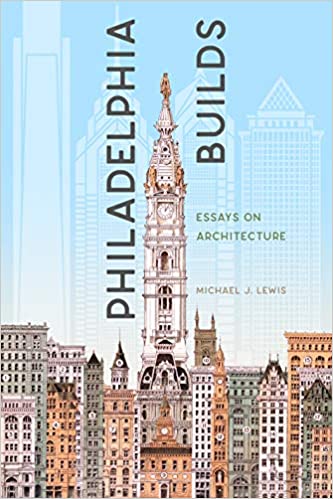
Shakspere Society of Philadelphia
Maybe not the first, but the oldest Shakespeare club in America or possibly even the world, has kept minutes for over a hundred fifty years.
Frank Furness,(3) Rush's Lancer
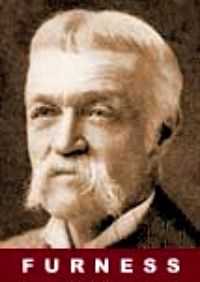
|
| Frank Furness |
Lunch at the Franklin Inn Club was recently enlivened by David Wieck, who not only does the sort of thing you get an MBA degree for but is also a noted authority on the Civil War. His topic was the wartime exploits of Frank Furness, whose name is often mispronounced but whose thumbprints are all over the architecture of 19th Century Philadelphia. Take a look at the Pennsylvania Academy of Fine Arts, Boathouse #13 of the Schuylkill Navy, the Fisher Building of the University of Pennsylvania, and many other surviving structures of the 600 buildings his firm built in 40 years. One of them is the Unitarian Church at 22nd and Chestnut, where his grandfather had been the fire-brand abolitionist minister.
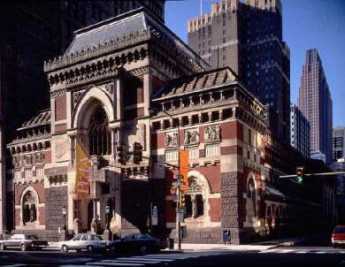
|
| PennsylvaniaAcademy of Fine Arts |
The Civil War seems to have transformed Frank Furness in a number of ways. He had been sort of in the shadow of his older brother Horace, a big man on the campus of Princeton, later the founder of the Shakspere Society, and the Variorum Shakespeare. Frank was quiet, and good at drawing. However, at age 22 he was socially eligible to join Rush's Lancers, the 6th Pennsylvania Cavalry, which contained among other socialites the great-grandson of Robert Morris, and a member of the Biddle Family who put up the money to equip the troop with 7-shot repeating rifles. Cavalry units like this were a vital weapon in the Civil War because they needed young well-equipped expert horsemen with a strong sense of group loyalty. Rifles were considered too expensive for infantry, who were equipped with muskets that took several minutes to reload, and were unwieldy because they were only accurate if they were very long. When bands of daredevils on horseback suddenly attacked with seven-shot repeating rifles, they could be devastating against massed infantry. A flavor of their bravado emerges from their rescue of General Custer's men from a tight spot, later known in the annals of the troop as "Custer's first last stand."
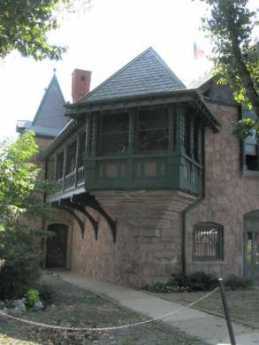
|
| The Undine Barge Club Boathouse #13 of the Schuylkill Navy |
There are two famous stories of the exploits of Frank Furness, first as a second Lieutenant and later as a Captain at Cold Harbor two years later. In the first episode, a wounded Confederate soldier lay on the no man's land of forces only a hundred yards apart. His screams were so heart-rending that Furness ran out to him and put a handkerchief tourniquet around his bleeding thigh. Because the fallen man was a Confederate soldier, the Confederates held their fire and later cheered the Union cavalryman for his kindness. The wounded man called out "
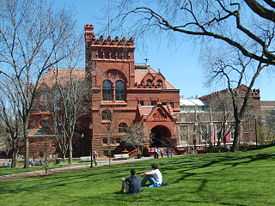
|
| The Fisher Building of the University of Pennsylvania |
In the second episode, the cavalry had spread out too much, leaving some isolated parties trapped and out of ammunition. Furness lifted a hundred-pound box of ammunition to his head and ran through the gunfire with it to the trapped men. For this, he later received the Congressional Medal of Honor. Somehow all of the public attention he received in the war transformed Furness from a younger brother who was good at drawing into a dynamo of energy, much in the model of what law firms call a "rainmaker". He traveled to the Yellowstone area of Wyoming at least six times, bringing back various trophies. He was known to get people's attention by using his service revolver to take pot shots at a stuffed moose head in his office.
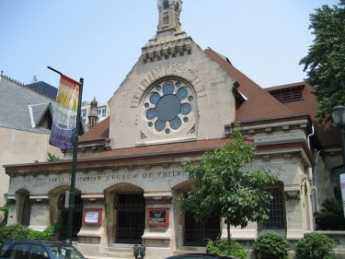
|
| First Unitarian Church 22nd Chestnut Philadelphia |
His final publicity venture was to advertise, forty years later, in Southern newspapers for the whereabouts of the Confederate soldier whose life he had saved. Eventually, a man named Hodge who had later been a sheriff in Virginia, stepped forward to renew his blessings and thanks. Hodge was brought to Philadelphia for a celebrated 6th Cavalry reunion, and a picture of the two former enemies was spread in the newspapers. It was a little embarrassing that Furness and Hodge found they had very little to say to each other for a five-day visit, but Hodge eventually proved able to be one-up in the situation. He outlived Furness by five years.
Although the style of Furness confections seemed and seems a little strange to everyone except Victorian Philadelphians, he did leave a major stamp on American architecture. His most noted student was Louis B. Sullivan, who put an entirely different sort of stamp on Chicago. And Sullivan's best-known student was Frank Lloyd Wright who created a modernist image of architecture for the West. The buildings of these three don't look at all alike, but their rainmaker personalities are all essentially the same.
Originally published: Thursday, September 11, 2008; most-recently modified: Monday, May 20, 2019
| Posted by: Barbara | Jun 27, 2013 4:09 PM |
| Posted by: m. sabur | Jul 11, 2009 10:44 AM |
| Posted by: Anthony | Jun 25, 2009 5:27 PM |